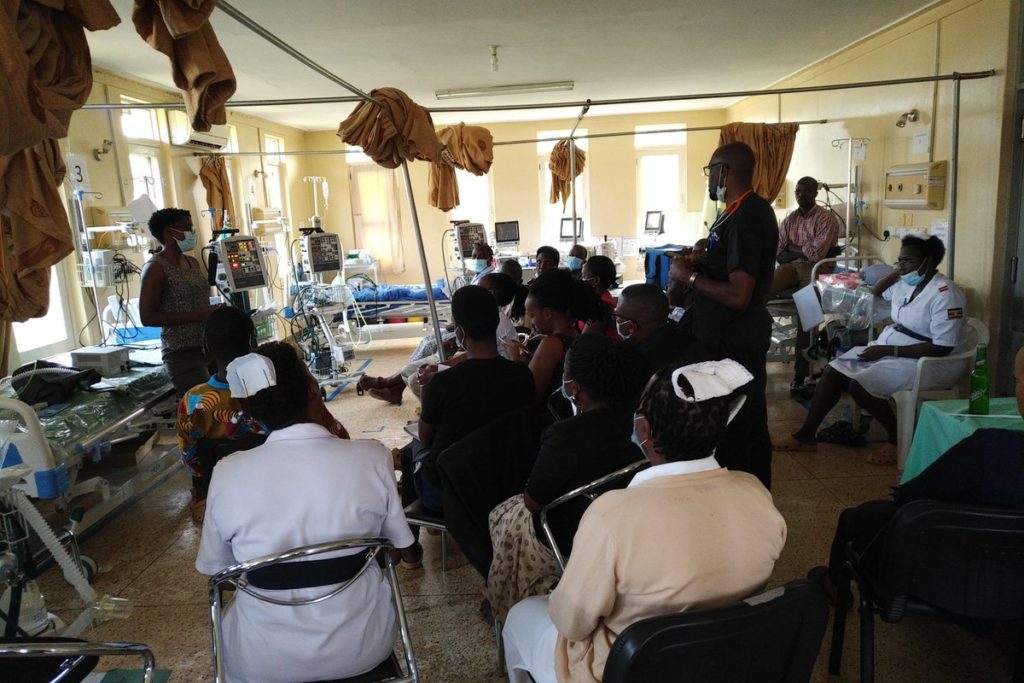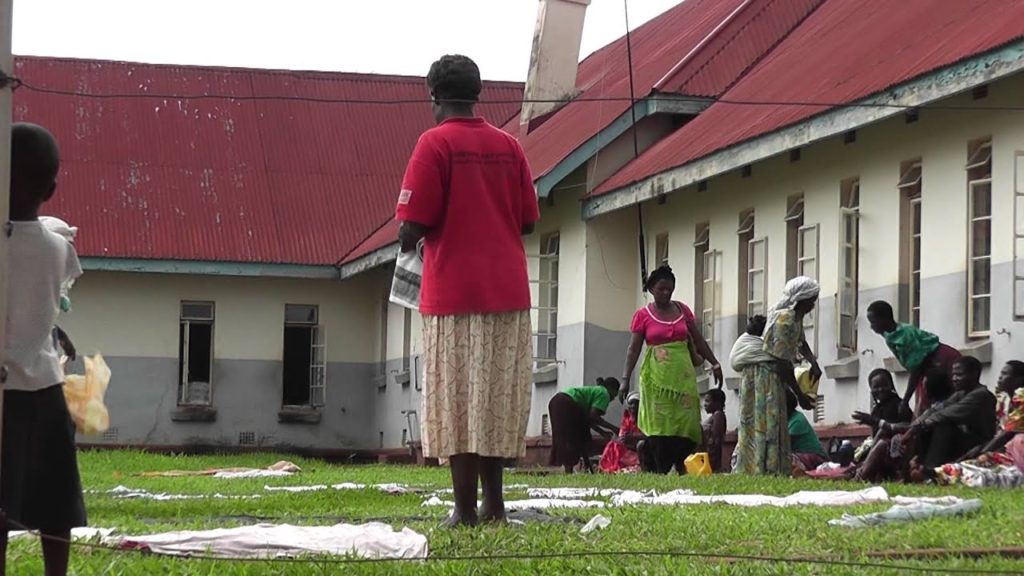On the night of Saturday September 12, 2020, Shaban Nkuutu Muziransa, a lawyer based in the eastern city of Jinja was cruising back home along the Kayunga-Jinja highway when he ran into the rear of a truck loaded with sugarcane. Like the March 22, 1990 accident in the Nigerian town of Lagos that changed forever, the life of globally acclaimed author Chinua Achebe, Nkuutu’s car accident was life changing. Achebe, of the Things Falls Apart novel fame got a second chance at life and died in 2013, having lived in a wheelchair thereafter. Nkuutu was not as lucky. The truck had apparently lost power and failed to make its way to the top of Naminya hill. It started rolling back towards whence it had been coming from, gaining momentum as it went along. Poor visibility and speed made it practically impossible for the lawyer to avoid a collision that left him badly hurt.
He was rushed to Jinja Referral Hospital, a logical decision since it was the nearest point of call and because the facility has an Intensive Care Unit (ICU) that was commissioned in July 2009. The ICU should have been the best suited facility to deal with a case such as that of the deceased lawyer, doctors say. Nkuutu was, however, turned away. The family was forced to evacuate him to another facility in Kampala. The difference between life and death was razor thin. He never made it.
Five days later and under different circumstances, another accident occurred along the same road and in very close proximity to the spot at which the one that claimed Muziransa’s life had occurred. A sugarcane-carrying-truck rammed into the rear of the vehicle of a young entrepreneur, Chris Rosh Kibedi. He too was rushed to Jinja Regional Referral Hospital where medics determined him a candidate for the ICU. This businessman, like Nkuutu, two citizens with fair access to money by Ugandan standard and a bit of power, was also turned away. He too died in the middle of preparations to evacuate him to Kampala.
The two tragic deaths that could have probably been averted have since placed the ICU here under the spotlight. What went wrong? Well, believers of fate could argue that it was, after all, “their day” and no amount of human effort could save them but President Yoweri Museveni has questioned this attitude. The 76-year-old president recently asked rhetorically, “Africans die early, and they say God has called them. Why does God like to call Africans? Japanese die at 79 years but you Africans, He calls you too early. I do not think it is God calling you. I think it is Satan taking our people.”
The president makes an important point in his matter-of-factly statement. There is then, one can safely argue, such a thing as ‘avoidable death’ or death that should not have happened to a 47-year-old man had some factors been better managed. The two accidents of the lawyer and the businessman and the Jinja Hospital ICU saga, speak volumes. As the country’s Covid-19 numbers start to rise and some potential ICU cases emerge, the state of intensive and critical care in our medical facilities shall return to the spotlight, if not, to haunt us, as a nation.

Closed ICU
A physician at the hospital, Dr. Asad Muyinda revealed that the two had been turned away because the ICU had been shut down four days before the first accident. Dr. Muyinda revealed that a patient who had earlier been admitted with suspected pneumonia was later found to have been infected with Covid-19 and succumbed to the same on September 7, which prompted the authorities to close off the facility. “The staff had been ordered to go into isolation because they had treated the deceased patient without full protection. The closure was also meant to allow for fumigation of the premises,” Dr Muyinda said.
Are ICUs prepared?
If a single death could lead to the closure of an ICU for more than two weeks, what would happen if there was a spike in cases? Are the ICUs in their present state able to manage the volatile situation if there was a spike in infections? On April 20 the Minister of Health, Dr Jane Ruth Aceng, issued a statement before parliament in which she indicated that ICU facilities for critical cases would be provided with each of the regional referral hospitals taking in at least 10 beds each.
Other ICU facilities were expected to be provided at Mulago National Referral Hospital which was meant to have 63 ICU beds. The Women’s Specialised Hospital at the facility was meant to have 65 ICU beds. In his May 18 address, one of the many televised Covid-19 related speeches Mr. Museveni has delivered to a nation gripped by anxiety, he explained that the lockdown had helped government make adequate preparations to manage a rise in cases. He noted that on top of the specialised treatment centers in Entebbe, Mulago and the Women’s specialised hospital, 14 treatment centers had been set up at the 14 regional referral hospitals across the country. Figures from the Ministry of Health indicate that out of the $172.637million that had been spent as at the end of May 2020, $32.674million was expended on the procurement of among others, beds, accessories and equipment for ICUs.
That would suggest adequate preparedness, but the figures say otherwise.

According to the acting commissioner in charge of health infrastructure at the Ministry of Health, George Otim, installation of ICU beds and ventilators has been concluded at Mulago Hospital and regional referral hospitals in Jinja, Lacor, Lira, Kabale, Fort Portal and Mbale.
145 ICU beds including ventilators, patient monitors, X-rays, oxygen plants and high flow oxygen therapy apparatus, he shared, have been procured. The 145 ICU beds have been distributed to 13 regional referral hospitals and four other selected hospitals, Otim says.
The Health Minister in the People’s Government, a loose coalition of people rallying under and rallied by four-time presidential candidate Kizza Besigye after the 2016 general election, Dr. George Ekwaro thinks that government’s Covid-19 response is, “a miserable failure” and that, “the intervention would be inadequate if there was a spike in the number of cases.” Uganda has been on the receiving end of flowery praise by sections of international bodies and media houses for what is said to be a comparatively better management of the pandemic thus far but medics like Ekwaro are worried that above this horizon of glee hover clouds of gloom.
“The world over, serious governments strengthened their health systems by recruiting more health workers, increased health sector budget above 7% of GDP, built new health facilities to take care of possible surge in cases, strengthened surveillance and testing capacity, strengthened immunity of their people by providing them with food fortified with vitamins,” Dr Ekwaro said in an interview with Vox Populi.
On his part, Otim is persuaded that more is being done especially in the area of adding to infrastructure in place to handle health challenges imposed by Covid-19.
“There are plans to procure more oxygen plants and oxygen cylinders for transportation of oxygen to General Hospitals and Health Centre IVs across the country,” he says, with a tinge of optimism in his voice.
Manpower shortages abound
A summary of the budget allocation for Covid-19 response for health, shows that slightly under Shs. 4 billion was allocated towards the recruitment of more manpower for on three-month contracts and deployment of at least 250 extra staff.
However, if what the Public Relations Officer of the Association of Anesthesiologists of Uganda (AAU), Arthur Kwizera, says is anything to go by, if the recruitment was carried out, it did not serve to address the manpower shortages in Uganda’s ICUs.
“The area of Anesthesia and intensive health care is extremely under resourced,”Kwizera says. The spokesperson of the Ministry of Health, Emmanuel Ainebyona, concedes that there are challenges around intensive health care, but quickly adds that the ministry is addressing them, one step at a time, slow but sure.
“Although, Uganda has not attained the number of the desired critical care workers, a number are currently being trained under fully paid scholarships by the Ministry of Health,” Ainebyona says.
No anesthesiologists
On June 13, 1992, the World Federation of Societies of Anesthesiologists (WFSA) adopted standards to guide anesthesia care. The standards were revised in 2008 and 2010 and updated by the World Health Organisation (WHO) in May 2018. Those guidelines provide for among others, continuous presence of a trained and vigilant anesthetist and a system for transfer of care at the end of anesthesia. Attainment of such standards seems to be a bridge too far for countries in Sub-saharan Africa to cross. Uganda has been suffering from acute shortage of anesthetists for close to three decades.
“Under ideal conditions, every referral hospital is meant to have at least three anesthetists and a national referral hospital at least 55, but that is not the case. The only referrals that have the required three are Mbarara and Mbale. Kabale and Lacor have two each, while Jinja and Masaka have one a piece. The others do not have,” Kwizera says. This suggests that there is only one anesthesiologist for every 100,000 people. Uganda is, effectively, miles behind in the pursuit of the target of at least 5-10 for every 100,000 people by 2030 as recommended by WHO and the Lancet Commission on Global Health.

Ainebyona says that the Ministry has so far awarded scholarships to 16 scientists to study medical anesthesia. Seven of these have completed the specialised training. The health ministry’s strategy is to provide more scholarships as it works towards closing the deficit.
But then again….no nurses
Ideally, an ICU should have at least 36 nurses. There should be at least two nurses working on every patient in an ICU. Each nurse must be on duty for not more than eight hours a day but shortages have meant that nurses have often had to put in extra hours.
An official in the Ministry of Health who preferred not to be named since he is not authorised to speak for the institution revealed that the Association of Anesthesiologists of Uganda (AAU) submitted a proposal that would have facilitated the commencement of courses for nurses in the area of intensive health care. The course which had been proposed to be undertaken in both Makerere and Mbarara Universities are yet to take off. Ainebyona argues that scholarships were with secured with the help of the World Bank offered to 721 health workers to be trained in critical nursing and more scholarships are on the way.
“An additional 400 health workers are to be trained in critical care nursing with funding from the World Bank. Many of the health workers who should have completed their studies were unable to complete because of the COVID-19 pandemic,” Mr Ainebyona says.
In its current state, Uganda’s intensive and critical care system, confident though the government is about the progress it has made, continues to limp. If the grim reality witnessed by the families of victims in Jinja is anything to go by, there is reason for concern, especially as the country’s Covid-19 curve stubbornly refuses to flatten. Just how many ICU cases of Covid-19 can the country’s ICU system hold? 100? 200? We cannot tell. What is easy to tell is the agony and anguish of victims like those most recently witnessed in Jinja.









Thanks for in-depth analysis of Anaesthetic services in Uganda.Iam Anaesthetic officer,who has practiced Anaesthesia&ICU for almost fifty years.There is progress but also many challenges.Oxygen supply,is a big challenge, organization & training is another one.All is not lost.